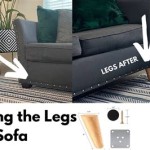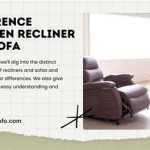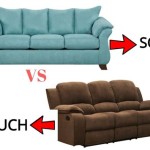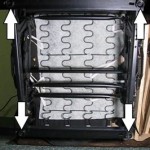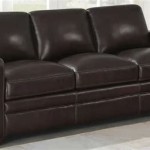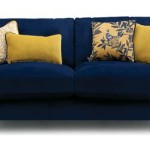Understanding Faux Leather Sofas: A Comprehensive Guide
Faux leather sofas, also known as synthetic leather or pleather sofas, have become increasingly popular. This is due to several factors, including their affordability, durability, and aesthetic appeal. Understanding the composition, properties, advantages, and disadvantages of faux leather is crucial for making an informed purchasing decision. This article provides a comprehensive overview of faux leather sofas, encompassing various aspects from manufacturing processes to maintenance tips.
The term "faux leather" encompasses a wide range of materials designed to mimic the look and feel of genuine leather. However, unlike genuine leather, which is derived from animal hides, faux leather is entirely synthetic. The most common types of faux leather used in sofa construction are Polyurethane (PU) and Polyvinyl Chloride (PVC). Each material possesses distinct characteristics affecting durability, texture, and overall performance.
PU faux leather typically offers a more realistic leather appearance and a softer, more supple feel. It's created by coating a fabric backing, such as cotton or polyester, with a layer of polyurethane. This allows for more breathability and flexibility compared to PVC. PVC faux leather, on the other hand, is generally more resistant to scratches and stains but often lacks the natural texture and pliability of PU. The choice between PU and PVC depends on factors such as budget, desired aesthetic, and expected level of use.
Key Point 1: Composition and Manufacturing Processes
The fundamental difference between genuine and faux leather lies in their composition. Genuine leather is a natural material processed from animal hides, making it a byproduct of the meat industry. Faux leather, conversely, is a manufactured product. This distinction directly impacts the material's properties, environmental footprint, and ethical considerations.
The manufacturing of PVC faux leather involves polymerizing vinyl chloride. The resulting PVC resin is then mixed with plasticizers, stabilizers, and pigments to achieve the desired flexibility, durability, and color. This mixture is then applied to a fabric backing, typically through a coating or calendaring process. The calendaring process involves pressing the PVC mixture between rollers to create a uniform sheet, which is then bonded to the fabric.
The production of PU faux leather is more complex. It involves applying a polyurethane coating to a fabric backing, often followed by embossing to simulate the grain pattern of genuine leather. PU can be produced using various techniques, including direct coating, transfer coating, and spray coating. Direct coating involves applying the PU directly to the fabric, while transfer coating applies the PU to a release paper, which is then bonded to the fabric and the release paper is removed. Spray coating involves spraying a layer of PU onto the fabric. The choice of technique affects the final product's texture, durability, and breathability.
The environmental impact of faux leather production is a subject of ongoing debate. PVC production can involve the release of harmful chemicals, while PU production often requires the use of solvents. However, advancements in manufacturing technologies are leading to more environmentally friendly faux leather alternatives. These include water-based PU and bio-based materials that utilize renewable resources in their production.
Key Point 2: Advantages of Faux Leather Sofas
Faux leather sofas offer several advantages that contribute to their widespread appeal. One of the primary advantages is their affordability. Faux leather sofas are typically significantly less expensive than sofas upholstered in genuine leather. This makes them an attractive option for budget-conscious consumers seeking the aesthetic of leather without the high price tag.
Another significant advantage is the ease of maintenance. Faux leather is generally easier to clean than genuine leather. It is resistant to stains and spills, requiring only a damp cloth and mild soap for routine cleaning. Genuine leather, on the other hand, requires specialized cleaning products and techniques to prevent damage and maintain its appearance. This ease of maintenance makes faux leather sofas a practical choice for households with children or pets.
Durability is another key benefit. While not as durable as high-quality genuine leather, faux leather is resistant to scratches, tears, and fading. PVC faux leather, in particular, is known for its durability and resistance to wear and tear. PU faux leather, while less scratch-resistant than PVC, offers greater flexibility and resistance to cracking. This durability makes faux leather sofas a long-lasting investment, especially when properly cared for.
Furthermore, faux leather offers a wider range of design options. It can be produced in various colors, textures, and patterns, allowing for greater design flexibility. This allows manufacturers to create sofas that closely resemble genuine leather while also offering unique and contemporary designs. The availability of numerous design options makes faux leather sofas suitable for various interior design styles.
Ethical considerations also contribute to the popularity of faux leather. As a synthetic material, faux leather does not involve the use of animal products. This makes it an appealing choice for consumers who are concerned about animal welfare. The growing awareness of ethical sourcing and production practices has further increased the demand for faux leather products.
Key Point 3: Disadvantages and Considerations
Despite the numerous advantages, faux leather sofas also have some drawbacks. One of the primary disadvantages is their lack of breathability compared to genuine leather. Faux leather does not allow air to circulate as freely, which can lead to discomfort in hot or humid conditions. This can result in the sofa feeling sticky or clammy, particularly after prolonged use. However, some PU faux leathers offer improved breathability compared to PVC.
Another disadvantage is the perception of lower quality. While faux leather has improved significantly in recent years, it is still often perceived as being less luxurious and durable than genuine leather. This perception can affect the resale value of the sofa, as genuine leather is generally considered a more desirable material.
The lifespan of faux leather sofas can also be a concern. While durable, faux leather is susceptible to cracking and peeling over time, especially with heavy use. This is particularly true for low-quality faux leather made with inferior materials and manufacturing processes. Genuine leather, on the other hand, can last for decades with proper care, developing a patina over time that enhances its character.
Furthermore, the environmental impact of faux leather production remains a concern. While advancements are being made in sustainable faux leather alternatives, the traditional production of PVC and PU faux leather can involve the use of harmful chemicals and solvents. Consumers who are environmentally conscious should carefully consider the environmental footprint of the faux leather they choose.
When choosing a faux leather sofa, it is crucial to consider the quality of the materials and construction. Look for sofas made with high-quality faux leather and sturdy frames. Read reviews and check for warranties to ensure that the sofa is durable and will withstand regular use. Proper care and maintenance can also extend the lifespan of a faux leather sofa.
Consider the specific needs and lifestyle when selecting a faux leather sofa. For households with pets or children, PVC faux leather may be a better option due to its superior scratch and stain resistance. For those seeking a more luxurious feel and appearance, PU faux leather may be preferred. Ultimately, the best choice depends on individual preferences and priorities.
Faux leather sofas represent a practical and affordable alternative to genuine leather. By understanding the composition, advantages, and disadvantages of faux leather, consumers can make informed decisions that align with their budget, lifestyle, and ethical considerations. While faux leather may not possess the same inherent qualities as genuine leather, it offers a compelling combination of style, durability, and affordability that makes it a popular choice for modern homes.
The evolving landscape of faux leather technology continues to yield improved materials with enhanced durability and environmental friendliness. Exploring these advancements ensures a purchase aligned with both aesthetic preferences and responsible consumption. Thorough research and careful consideration of the various aspects presented in this guide will lead to a satisfactory and long-lasting faux leather sofa investment.

Hillsdale Jianna Faux Leather Sofa Saddle Brown Com

Brown Wyatt Faux Leather Sofa Kirklands Home

Hillsdale Jianna Faux Leather Sofa Grey Com

Novato 3 Seater Faux Leather Sofa Home Centre Uae

Temple Webster Bungalow Premium 3 Seater Faux Leather Sofa

Brown Vintage Italian Modern Faux Leather Sofa With Metal Leg For Living Room China Furniture Made In Com

Cara Faux Leather Sofa

Temple Webster Thiago 3 Seater Premium Faux Leather Sofa

Zoe Faux Leather Left Hand Corner Sofa Dunelm

Vonanda Faux Leather Sofa Couch Mid Century 73 Inch 3 Seater With 2 Bolster Pillows And Hand Stitched Cushion For Living Room Caramel Com

